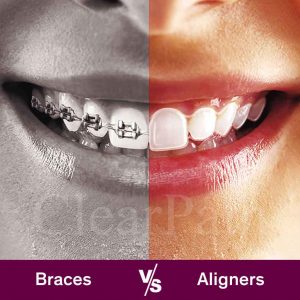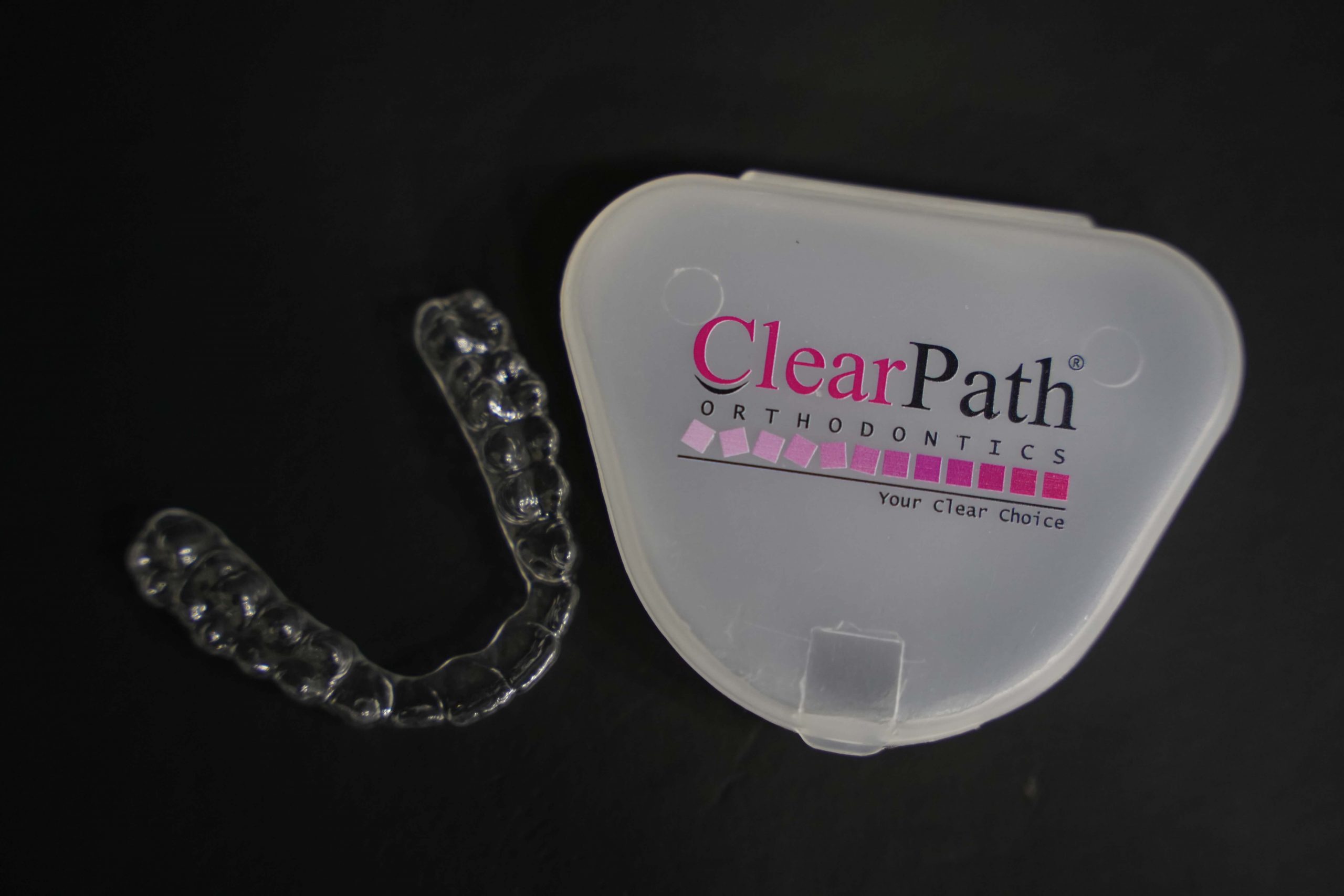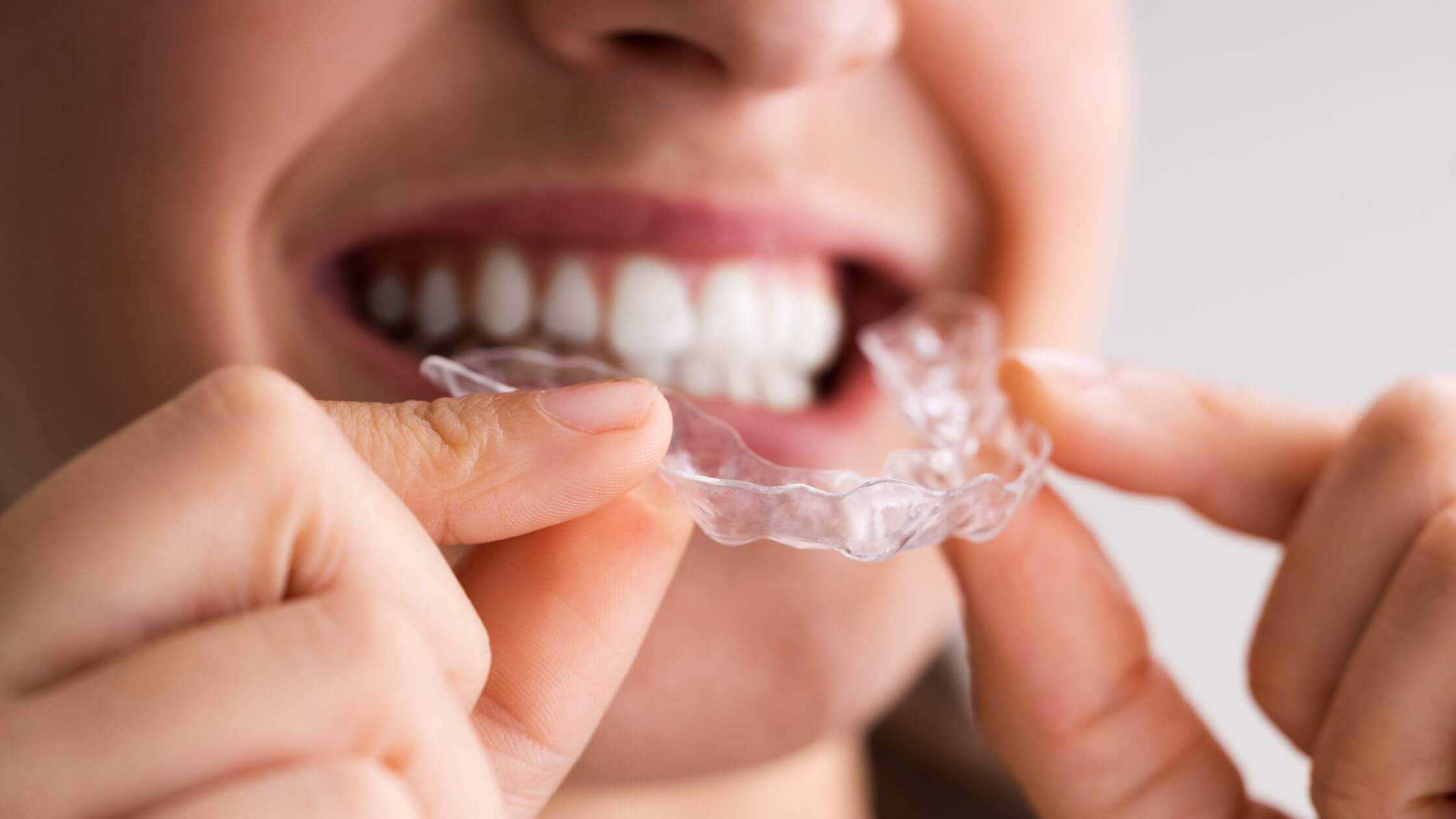Table of Contents
ToggleThe Plaque Predicament and Clear Aligners
Have you ever woken up to the unwelcome sensation of a fuzzy film on your teeth? If Yes then that’s an unmistakable sign of plaque
Running your tongue over your teeth may reveal this sticky substance, which not only is an unpleasant sensation but a threat to your oral and overall health.
Understanding plaque, its impact on teeth and gums, and its significance for clear aligner wearers is paramount.
Just like an online casino game where you may experience vague wins or wins that you don’t always remember, plaque is something that can hit you when you least expect it. Plaque, like casino bonuses, can be unpleasant and threaten the health of the oral cavity, which requires attention and care. Like many most secure online casinos, taking care of your teeth and getting rid of plaque can be an important part of your oral health ritual.
Plaque, a sticky film of bacteria thriving on sugars, poses a direct assault on tooth enamel. Left unaddressed, it transforms into tartar, particularly problematic for clear aligner wearers.
The oral microbiome, responsible for maintaining oral health, experiences disruption with the intrusion of plaque. This balance is especially delicate for those utilizing clear aligners.
Clear aligners, while discreet in their smile transformation, create spaces where plaque can thrive. Mismanagement of plaque jeopardizes aligner effectiveness, inviting hygiene issues and discomfort.
Combatting plaque requires an arsenal of oral care techniques, that include:
- Effective Brushing Techniques: Brushing twice a day with a soft-bristled toothbrush and fluoride toothpaste is crucial. Cover all surfaces, including between aligners and teeth.
- Flossing: Navigate tight spaces with floss or interdental brushes to remove plaque between teeth and aligner attachments.
- Mouthwash: Consider antimicrobial or fluoride mouthwash as an additional defense for comprehensive care.
If you wear clear aligners then you’ll need to follow a hygiene routine that goes something like this:
| Oral Health with Clear Aligners | Description |
| Pre-aligner Care: | Ensure teeth are clean before wearing aligners |
| Aligner Care: | Regularly clean aligners with a soft toothbrush and clear, antibacterial soap. |
| Midday Rinses: | Rinse mouth and aligners after meals to curb plaque buildup. |
| Regular Checkups: | Non-negotiable regular dental checkups allow dentists to spot plaque and provide professional cleaning, ensuring a smooth aligner journey. |
Incorporate effective oral hygiene practices, stay vigilant, and relish the confident smile aligners promise.
The Sticky Culprit: Unveiling Dental Plaque
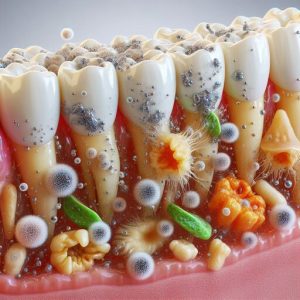
Plaque is a complex mix of bacteria, food debris, and saliva adhering to teeth.
Harmful bacteria in plaque cause decay and gum disease by producing acids. More plaque leads to increased acid production, causing damage.
Plaque forms constantly, starting as a thin layer and hardening over time. If not removed, it calcifies into tartar, requiring professional removal.
Tartar creates a rough surface, perpetuating plaque buildup.
Let’s delve into plaque’s intricacies, understanding its composition, diverse bacteria, and persistent threat to teeth.
Composition: Plaque combines bacteria, food debris, and saliva, setting the stage for oral health issues.
Bacteria Types: Diverse bacteria in plaque, some harmless, others causing decay and gum disease, highlight potential oral hazards.
Formation: Plaque begins as a thin film on teeth, fueled by dietary sugars, rapidly multiplying and becoming potentially damaging.
Understanding plaque’s composition, bacteria, and growth dynamics emphasizes that you follow the route of effective oral hygiene.
From Fuzzy Film to Big Trouble: Consequences of Plaque
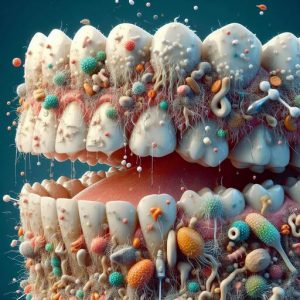
Plaque is the main cause of two common oral diseases:
- Dental caries (cavities)
- Gum disease (gingivitis and periodontitis).
Dental caries are holes in your teeth that form when plaque bacteria ferment sugars from your food and produce acids that dissolve your enamel.
The longer plaque stays on your teeth, the more acid is produced, and the deeper the cavity becomes.
If left untreated, cavities can cause pain, infection, and tooth loss.
Whereas, Gum disease is an inflammation of the gums caused by plaque bacteria that accumulate along the gumline.
In its early stage, called gingivitis, gum disease causes redness, swelling, and bleeding of the gums.
Gingivitis can be reversed with proper oral hygiene and professional cleaning. However, if gingivitis progresses to periodontitis, the inflammation spreads to the tissues and bones that support the teeth, causing them to loosen and fall out.
Plaque can also have negative effects on other parts of your body.
A 2019 review article by Chapple et al. concluded that plaque-induced gingivitis, a common form of gum inflammation caused by plaque, can adversely affect the quality of life and well-being of individuals and populations.
For example, plaque bacteria can cause endocarditis, an infection of the inner lining of the heart valves. Plaque bacteria can also increase the risk of heart disease and stroke by contributing to inflammation and blood clots in the arteries.**
Dental plaque, that seemingly harmless film on your teeth, is more than just an inconvenience.
Let’s delve into the substantial consequences that plaque can unleash on your oral health and beyond.
- Plaque’s Oral Havoc: Plaque, an enamel adversary, wreaks havoc by fermenting sugars in your diet, producing acids that erode enamel, and fostering cavity development.
- Plaque’s Impact on Gums: Beyond teeth, plaque orchestrates mischief in gum disease. Accumulating along the gumline, it sparks inflammation, progressing from gingivitis to periodontitis, culminating in bleeding, receding gums, and potential bone loss, jeopardizing tooth stability.
- Plaque’s Systemic Reach: Plaque’s repercussions extend beyond the oral realm. Research hints at links between oral health and systemic issues, associating endocarditis, heart disease, and more with poor oral hygiene. These connections underscore oral health’s pivotal role in overall well-being.
It’s about safeguarding the structural integrity of your teeth, maintaining healthy gums, and potentially mitigating risks associated with systemic health problems.
Detecting the Enemy
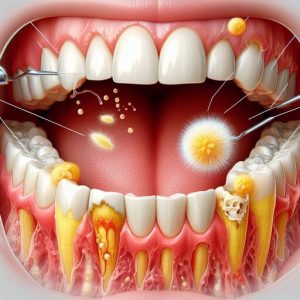
Achieving and maintaining healthy teeth and gums requires a proactive stance against the common adversary, plaque.
Identifying the subtle signs of dental plaque is the initial step in preserving optimal oral health.
Although plaque may be challenging to discern with the naked eye, especially in its early, colorless stages, certain indicators signal its presence, including:
| Indicators for Plaque Buildup | Description |
| A Fuzzy or Slimy Sensation | When you feel a fuzzy or slimy texture on your teeth, it may indicate the presence of plaque, particularly noticeable in the morning. |
| Bad Breath | Plaque’s acid production can lead to bad breath, serving as a warning sign of potential oral issues. |
| Gum Changes | Redness, swelling, or bleeding gums are indicative of inflammation, suggesting the onset of gum-related concerns. |
| Stains on Teeth | Yellow or brown stains on your teeth may signal the accumulation of plaque. |
Regular dental checkups are paramount for effective plaque management.
A 2017 cross-sectional study by AlJehani et al. found that plaque accumulation was significantly associated with poor oral health-related quality of life among Saudi adults.
For at-home plaque detection, consider the following methods:
- Disclosing Tablets or Solutions: These products stain plaque, making it visible and aiding in identifying areas that may require additional attention.
- Tactile Examination: Use your tongue or finger to feel for rough or sticky areas on your teeth, a potential indicator of plaque accumulation.
- Gumline Inspection: Check for gaps or pockets between your teeth and gums, areas prone to plaque buildup.
Understanding and recognizing the subtle cues of plaque’s presence empowers individuals to take timely action.
Whether through visible clues, awareness of bad breath, or at-home detection methods, maintaining vigilance ensures staying ahead of potential oral challenges.
Early detection serves as the linchpin for effective plaque management and the preservation of a healthy, radiant smile.
Fighting Back: Strategies for Plaque Control
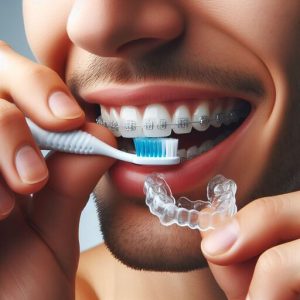
Achieving optimal oral health hinges on efficient plaque control, primarily through consistent brushing and flossing.
These practices disrupt plaque formation and eliminate the biofilm covering your teeth.
Here are the guidelines for effective brushing and flossing:
| Brushing & Flossing Techniques | Description |
| Brushing Technique: | Twice daily, use a soft-bristled toothbrush at a 45-degree angle to your gums, covering all tooth surfaces, including your tongue, for at least two minutes. |
| Toothbrush Selection: | Choose a toothbrush that fits comfortably, opting for a soft-bristled one, and replace it every three months or sooner if signs of wear emerge. |
| Toothpaste | Use fluoride toothpaste to strengthen enamel and prevent cavities. |
| Flossing Technique | Once daily, preferably at night, use about 18 inches of floss. Slide it gently between your teeth in a sawing motion, curving it around each tooth, ensuring it reaches below the gumline. |
| Floss Types | Choose from various types based on your preference and the size of the spaces between your teeth. |
Additional Tools to Combat Plaque:
- Mouthwash: After brushing and flossing, use mouthwash to rinse away remaining plaque and bacteria, enhancing the effects of fluoride. Remember, it’s not a substitute for brushing and flossing.
- Tongue Scrapers: Employ tongue scrapers to remove bacteria and debris, promoting better oral hygiene and fresher breath.
While these tools are valuable additions, they do not replace the fundamental brushing and flossing practices.
Consulting your dentist before incorporating mouthwash into your routine is advisable.
A 2016 randomized controlled trial by Kaur et al. found that plaque removal by professional scaling and root planing improved the psychological well-being of patients with chronic periodontitis, a severe form of gum disease caused by plaque.
Beyond Brushing: Advanced Plaque Removal Techniques
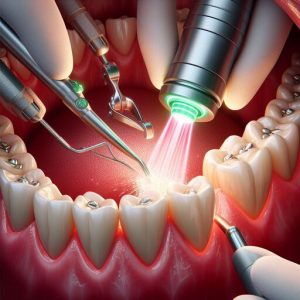
Daily brushing and flossing, while essential, may not suffice for hard-to-reach areas or deep gum pockets.
Professional plaque removal by dentists includes:
| Plaque Removal Techniques | Description | Benefits | Limitations |
| Scaling and Root Planing | Scaling addresses hardened plaque, while root planing smoothens tooth roots. | Effective plaque removal, gum disease prevention, and a healthier gum environment. | Discomfort, potential sensitivity, and multiple sessions for severe cases. |
| Air Polishing | Air polishing utilizes compressed air, water, and fine particles to remove surface stains and soft deposits. | Efficient plaque and stain removal, minimally invasive, suitable for dental sensitivity. | Less effective against hard deposits, potential messiness, and the need for protective eyewear. |
| Laser Dentistry | Focused light beams remove plaque and tartar, with applications in gum reshaping and disinfection. | Precision, minimal discomfort, reduced bleeding, potential tissue regeneration. | Cost, availability, and case suitability. |
These techniques complement, not replace, daily oral care. They address severe plaque buildup, preventing advanced gum disease and tooth decay.
Understanding their role underscores the comprehensive approach to oral health.
While addressing existing issues, prevention through consistent brushing, flossing, and regular dental checkups remains paramount.
Consulting your dentist helps determine the most suitable method, ensuring your teeth and gums remain healthy and plaque-free.
Living Plaque-Free: Maintaining a Healthy Mouth
To ensure optimal oral health and prevent plaque formation, consider the following practical tips:
- Diet Modifications: Tailor your diet by limiting sugary and acidic foods and drinks that can erode enamel, fostering plaque formation. Opt for teeth-friendly options such as cheese, yogurt, nuts, fruits, vegetables, water, and sugar-free gum.
- Regular Dental Checkups: Even with diligent oral care, biannual dental checkups are vital. Your dentist can detect early signs of issues, conduct a comprehensive cleaning, and address plaque or tartar that may be challenging to manage at home.
- Stress Management and Overall Health: Combat stress, a potential threat to oral health, by integrating stress-reducing practices like exercise and meditation. Prioritize overall well-being through sufficient sleep, hydration, and avoiding tobacco and alcohol, as a healthy body supports a healthy mouth.
Effectively combating plaque is crucial for maintaining a vibrant smile. Take prompt action during routine dental visits and incorporate these strategies to fortify your oral well-being.
Dealing with Plaque Buildup While Wearing Clear Aligners
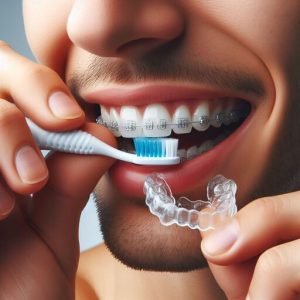
Maintaining optimal oral health while wearing clear aligners for teeth straightening requires specific hygiene practices to address the accumulation of dirt over time.
The aligners, snugly fitted against your teeth, create an environment where food particles and bacteria become easily trapped, fostering plaque buildup.
Hygiene Practices for Clear Aligner Wear
Removal and Cleaning: Take out aligners for comprehensive brushing and flossing at least twice daily, ideally in the morning and at night. This eliminates trapped particles, promoting cleanliness between your teeth and aligners. Rinse your mouth with water or mouthwash after meals to flush out any remaining debris.
Cleaning Aligners: Regularly clean aligners to prevent cloudiness and odors. Soak them in a specialized cleaning solution or gently brush them with a soft toothbrush and mild soap. Avoid hot water, abrasive toothpaste, or alcohol-based products to prevent damage or discoloration.
Tongue Scraping: Incorporate tongue scraping into your routine to prevent bad breath caused by plaque buildup. Use a tongue scraper or toothbrush to remove bacteria from the tongue’s surface.
Increased Plaque Risk
- Micro-Environment: The snug fit of clear aligners creates a micro-environment where food particles and bacteria accumulate against your teeth.
- Plaque Formation: Trapped particles create an ideal breeding ground for plaque, elevating the risk of dental issues.
Impact on Oral Health
The accumulation of plaque beneath aligners poses potential risks, that include:
| Impact of Plaque | Description |
| Tooth Enamel Erosion | Plaque can erode tooth enamel, potentially causing cavities requiring interventions like fillings or root canal treatments. |
| Gum Irritation | Plaque can irritate gums, leading to inflammation, bleeding, and infection risks. |
| Progression to Gum Disease | This may result in gum disease, damaging supportive tissues and bones anchoring teeth securely. |
| Bad Breath | Plaque generates malodorous gases, contributing to bad breath and impacting social interactions. |
Further Consequences
The consequences extend to cavity formation, especially in challenging-to-clean areas, leading to potential dental decay. Irritation from accumulated plaque on the gums may progress into inflammation, risking complications like gingivitis.
The thriving bacteria within plaque contribute to bad breath, influencing overall oral hygiene.
Essential Hygiene Practices for Clear Aligner Wearers
Most people strive for the quickest route to perfect cleaning. Some of the essential practices of achieving this feat are mentioned below.
- Removal and Cleaning: Emphasize the necessity of removing aligners for thorough brushing and flossing at least twice daily.
- Cleaning Aligners: Recommend soaking aligners in a specialized cleaning solution or gently brushing with a soft toothbrush and mild soap.
- Tongue Scraping: Encourage incorporating tongue scraping to eliminate bacteria, minimizing the risk of bad breath.
Consistent and meticulous care is crucial for preserving cleanliness and ensuring a positive journey to a straighter smile.
Additional Tips for Clear Aligner Maintenance
In addition to fundamental hygiene practices, incorporate effective strategies to mitigate plaque buildup while wearing clear aligners:
- Rinsing Frequently: Regularly rinse with water or a dentist-approved mouthwash throughout the day to maintain a clean environment. This flushes away food particles and bacteria, minimizing the risk of plaque buildup.
- Diet Adjustments: Limit sugary and acidic foods and beverages, including candies, chocolates, sodas, juices, coffee, tea, and wine. Drinking water helps neutralize acids, preventing dryness.
- Short Breaks: Take breaks, especially after consuming anything other than water, to remove and clean aligners. This proactive measure prevents stains or odors and provides breathing space for your teeth.
- Dentist Visits: Maintain regular dental checkups and cleanings every six months or as recommended. Your dentist can remove plaque or tartar under aligners and monitor overall oral health.
Wearing clear aligners effectively straightens teeth but poses challenges related to plaque buildup.
Understanding why this occurs, its potential impact on oral health, and adopting these practices ensures both teeth and aligners remain clean.
Practical Suggestions:
Certain suggestions can assist you with the fight against plaque. Some of the essential ones are mentioned in the table below.
| Suggestions | Description |
| Water or Mouthwash | Regularly rinse with water or a dentist-approved mouthwash to flush out lingering particles, ensuring a fresh mouth and minimizing plaque buildup. |
| Limit Sugary and Acidic Foods | Adjust your diet by restricting sugary and acidic foods and drinks to prevent plaque formation, preserving clear aligner effectiveness. |
| After Meals | Take breaks, particularly after meals, to remove and clean aligners. This proactive approach prevents debris accumulation, maintaining a clean environment. |
| Regular Checkups: | Emphasize the importance of regular dental checkups for professional plaque removal and monitoring overall oral health during clear aligner wear. |
Incorporating these tips complements daily care efforts, ensuring clear aligners remain effective throughout your orthodontic journey.
Consistency is crucial; seamlessly integrating these practices into your lifestyle fosters a healthier, more successful experience with clear aligners.
Further Information for Clear Aligner Users
As you embark on your clear aligner journey, understanding specific concerns and alternative cleaning methods is crucial. Here’s comprehensive guidance:
Addressing Common Concerns
There are some common concerns that you need to be wary of. Here’s how they can be addressed.
| Common Concerns | Description |
| Cleaning Procedures | Toothpaste: Toothpaste is too abrasive; opt for mild soap or a specialized cleaning solution. Ultrasonic Cleaner Usage: Yes, they’re effective, but follow with water rinsing. |
| Daily Wear Duration | Wear aligners for 20 to 22 hours daily, removing them only for essential activities. |
| Aligner Damage Concerns | Gentle Cleaning: Emphasize using a soft toothbrush and mild soap to avoid potential damage during cleaning. Avoiding Harsh Chemicals: Discourage harsh chemicals or abrasive materials that may compromise aligner integrity. |
| Alternative Cleaning Methods | Ultrasonic Cleaners: Utilize high-frequency vibrations for thorough cleaning. These are highly effective in eliminating debris, bacteria, and plaque. These are Convenient, thorough, and user-friendly. Cons: Higher initial cost, learning curve, technology dependence. |
| Balancing Oral Hygiene and Aligner Wear | Consistent Oral Hygiene Practices: Reinforce the symbiotic relationship between good oral hygiene and successful aligner treatment. Adhere to orthodontist-provided wear instructions for optimal treatment outcomes. |
Providing this information empowers clear aligner users to make informed decisions about cleaning methods while highlighting the pivotal role of consistent oral care.
A blend of effective practices and adherence to wear guidelines ensures a confident and healthy smile transformation.
A 2015 cohort study by Ide et al. found that plaque accumulation was associated with an increased risk of cognitive decline and dementia among elderly people. The study followed 5978 participants aged 60 and over for 10 years and assessed their cognitive function and dental status.
Maintaining Optimal Oral Health
Daily Commitment
Consistent plaque control offers enduring benefits such as a healthier mouth, fresher breath, and a brighter smile.
- By adhering to insights shared in this guide, you can ensure your oral health remains excellent, reaping the rewards of clear aligner therapy.
- Recognizing each individual’s unique oral health needs, regular consultations with your dentist are imperative.
Seeking personalized advice ensures accurate information and optimal solutions.
While the journey to optimal oral health may seem challenging, a healthy, plaque-free smile is entirely attainable with consistent care and expert guidance.
Whether you currently wear or contemplate clear aligners, our expert orthodontists are ready to assist.
Here’s to your journey towards a healthier, brighter smile! 🦷
Book a consultation today via the contact form below. Rest assured, all your details will be kept confidential.
FAQs
Q: What is plaque and how does it impact oral health?
Ans: Plaque is a sticky film of bacteria that forms on teeth and gums, leading to issues like tooth decay, gum disease, and bad breath. If not addressed, plaque hardens into tartar, a stubborn substance requiring professional removal.
Q: Can plaque be naturally removed, and what are the risks associated with home remedies?
Ans: While home remedies like baking soda or apple cider vinegar may help reduce plaque, they’re not a substitute for regular brushing and flossing. Consult your dentist before attempting natural remedies to avoid potential side effects such as enamel damage or gum irritation.
Q: What distinguishes plaque from tartar, and why is tartar removal essential?
Ans: Plaque is a soft, daily buildup on teeth, containing bacteria that erode enamel. Tartar, a hard, calcified form of plaque, forms when plaque isn’t removed. Tartar, unlike plaque, requires professional cleaning as it traps more bacteria, stains teeth, and can lead to gum irritation, inflammation, and bleeding.
Q: Is plaque on baby teeth normal, and how can parents ensure safe cleaning?
Ans: Plaque on baby teeth is normal but can lead to cavities and other issues if left untreated. Parents should establish good oral care early by wiping gums with a soft cloth after feeding. When the first tooth erupts, use a soft-bristled toothbrush and a small amount of fluoride toothpaste for gentle brushing twice a day. Regular dental checkups for advice on preventing plaque are crucial.
Q: Why might plaque increase during pregnancy, and what precautions should be taken?
Ans: Hormonal changes during pregnancy can elevate plaque levels, leading to gingivitis. This mild gum disease, characterized by redness, swelling, and bleeding, may impact both maternal and fetal health. Maintaining proper oral hygiene with regular brushing, flossing, and using antibacterial mouthwash is crucial. Avoiding sugary foods, maintaining a balanced diet, and regular dental checkups further contribute to preventing plaque-related complications during pregnancy.






